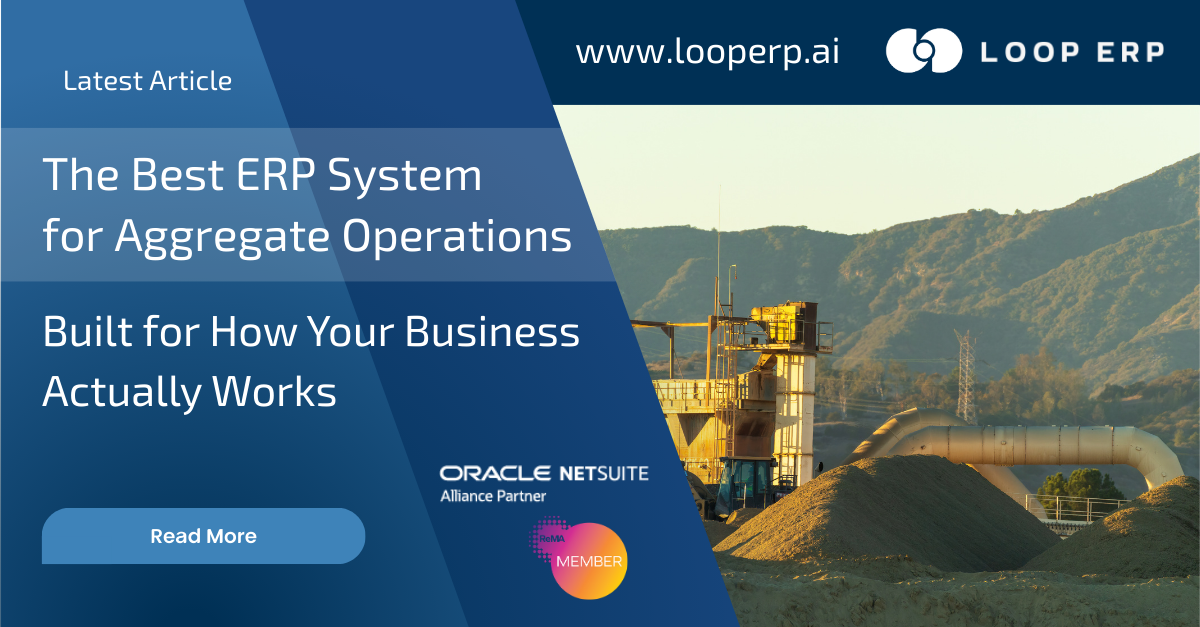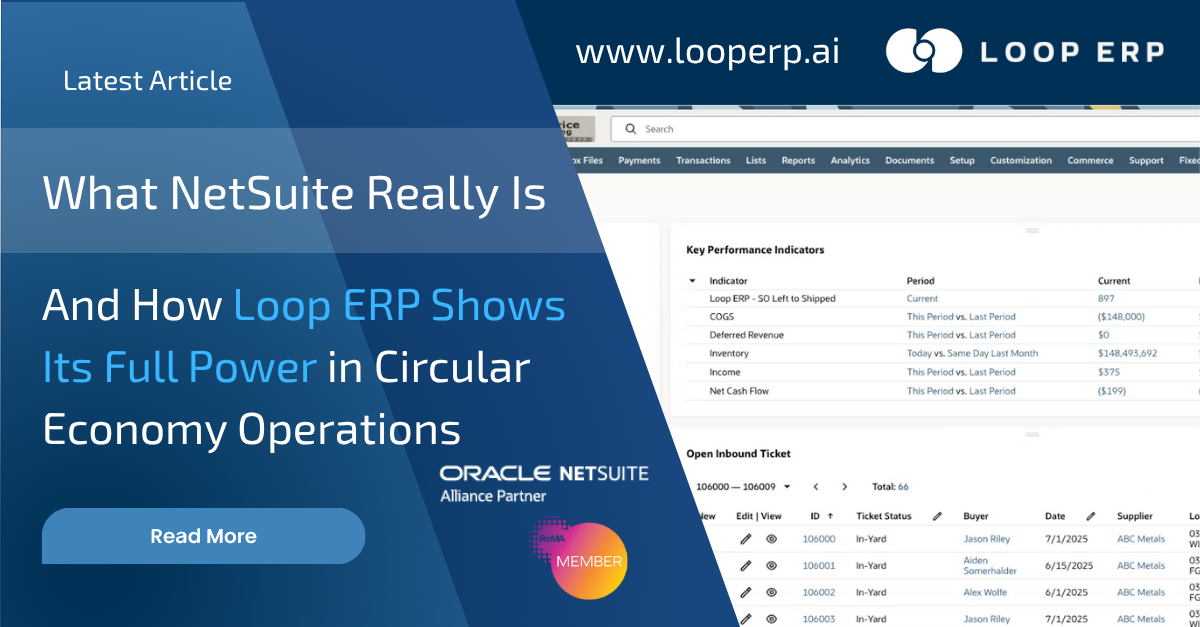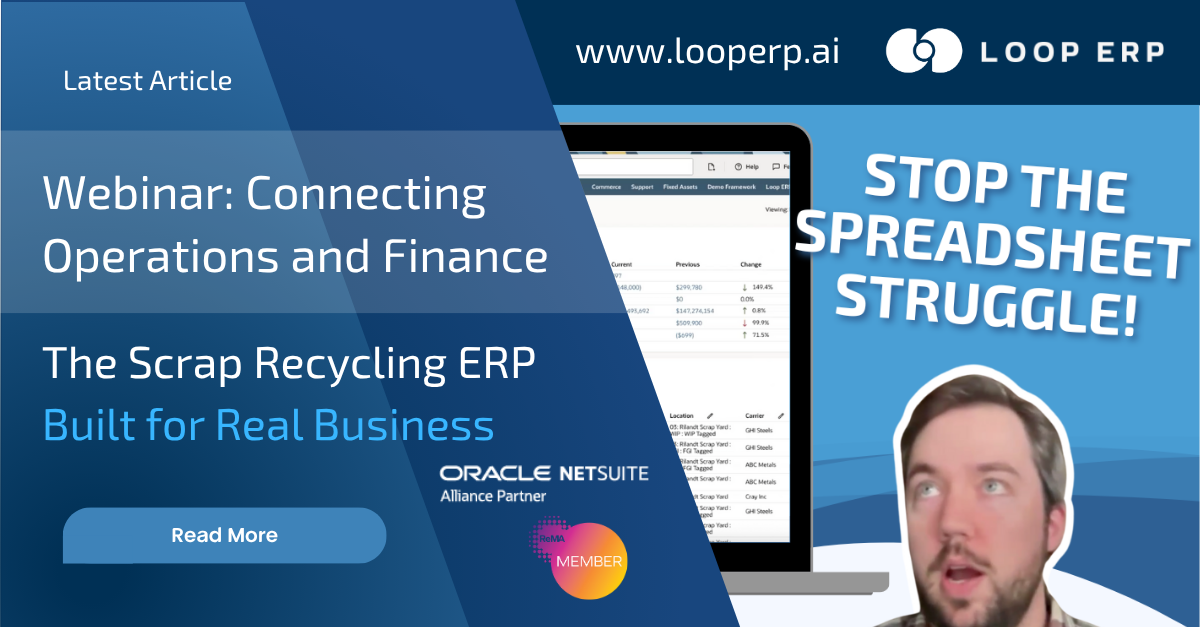In the world of scrap metal, waste management and aggregate supply, a fundamental truth sets these industries apart from conventional manufacturing or distribution: inventory undergoes physical transformation after acquisition. Raw materials change form, composition and value as they move through processing stages, yet traditional inventory systems remain blind to these transformations, creating a critical gap between operational reality and financial reporting.
Conventional inventory management systems were designed for businesses where products maintain consistent identity throughout their lifecycle. A ‘widget’ entering inventory remains the same widget until sold. A pallet of retail goods retains its form and value from receiving dock to customer delivery.
But what happens when your business model centers on material transformation? When the mixed metal you receive becomes five separate products through processing? When contaminated plastic scrap becomes clean with triple the value? When raw aggregate transforms into specific-grade construction materials?
Traditional inventory systems handle transformation businesses through crude workarounds that fail to capture operational reality. Most conventional systems force perpetual "adjustment" transactions to reconcile system inventory with physical reality after transformation processes. These adjustments create significant problems for financial reporting, audit trails, and profitability analysis.
When materials undergo weight and grade changes, traditional systems can't connect the original purchase to the final product without these artificial adjustment entries that obscure the actual value creation process. Finance teams spend countless hours reconciling these discrepancies, often creating elaborate spreadsheets outside the system to track what should be fundamental business data.
Many operations resort to treating entire processing areas as inventory "black boxes" where materials disappear from one category and mysteriously appear in another. This approach sacrifices all visibility into process efficiency, recovery rates, and transformation economics. Without granular tracking through conversion stages, businesses can't accurately determine which processes actually create value versus those that might be operating at a loss when all costs are properly allocated. This visibility gap forces management decisions based on aggregated performance data that masks critical operational issues requiring attention.
Most ERP Systems are not designed for material transformation and typically apply simplistic average costing methodologies that obscure actual material economics. When high-value and low-value materials blend in averaging calculations, the resulting "blended rate" fails to reflect true material costs or value creation. This distortion makes it impossible to accurately assess which incoming materials offer the best processing ROI or which customers provide the most profitable relationships. The lack of granular cost tracking essentially subsidizes lower-quality materials at the expense of premium streams, often leading to poor purchasing decisions that appear reasonable under misleading average cost models.

Loop ERP was built specifically to address the unique inventory valuation challenges faced by transformation industries. The system's dynamic inventory valuation capabilities create a continuous digital thread that follows materials through physical changes, maintaining financial accuracy while reflecting operational reality.
At the core of Loop's approach is a weight-centric inventory model that recognizes the fundamental reality of transformation businesses: weight, not item count, defines inventory quantity.
Loop provides seamless conversion between different weight units throughout the inventory lifecycle, supporting operational flexibility while maintaining accounting integrity. The system handles metric tons, short tons, pounds, kilograms, and other measurement units simultaneously, automatically converting between them based on user preferences and reporting requirements. This capability eliminates the common problem of weight unit mismatches between receiving, processing, and shipping operations that often create reconciliation headaches. Each facility or department can work in their preferred units while the system maintains a consistent underlying measurement framework for financial reporting.
Loop implements sophisticated tare weight handling that distinguishes between gross, tare, and net weights at every inventory transaction. The system supports both standard container weights and actual scale-captured tare weights to calculate true net material values. This tare handling proves especially critical for high-value materials where container weight might represent a significant percentage of gross weight. Beyond simple weight calculations, the system maintains container tracking and reconciliation to ensure accurate inventory in environments where containers themselves represent valuable assets. This comprehensive approach ensures that inventory valuation reflects only the actual material value without container weight distortions.
Loop enables correlation between weight, volume, and density measurements, creating a multi-dimensional view of inventory that supports different operational perspectives. The system can automatically calculate volume based on weight and density values, or conversely determine implied density from weight and volume inputs. This multi-measure capability proves particularly valuable for businesses handling both dense metals and high-volume, low-density materials where different measurement approaches make operational sense. The system maintains proper unit conversions throughout these calculations, eliminating the errors that often occur when converting between weight and volumetric measures in manual systems.
"Traditional inventory systems fail to capture the complexities of material transformation, leaving businesses blind to operational realities and distorting financial reporting. Accurate tracking through transformation stages is essential for true value creation."
Loop's most distinctive capability is its transformation tracking - the ability to follow materials through conversion processes that change weight, grade, form, and value.
Loop implements logical transformation workflows that accurately document how incoming materials become different outgoing products through processing. The system supports both simple conversions (basic sorting operations) and complex multi-stage transformations where materials undergo significant physical changes. Users can define specific conversion "recipes" that reflect expected transformation ratios, by-products, and yield rates for different process combinations. These predefined transformations streamline transaction entry while creating consistent documentation of conversion activities. The resulting process history provides detailed insight into how specific incoming loads progressed through conversion stages, maintaining the connection between original cost basis and final products.
Loop provides sophisticated yield analysis that compares actual transformation results against expected recovery rates, highlighting process efficiency and material quality variations. The system maintains both theoretical recovery models and actual historical performance data, allowing continuous comparison of expected versus actual results. These comparisons automatically flag statistically significant variations that might indicate process problems, material quality issues, or calibration errors in measurement systems. Over time, this yield analysis builds detailed performance profiles for different material sources, processing equipment, and operator crews - creating invaluable operational intelligence that drives continuous improvement.
Loop supports sophisticated by-product and co-product handling, ensuring all value streams are properly tracked and valued rather than treated as process losses. The system allocates both costs and revenues across multiple output streams based on configurable distribution methods including relative weight, relative market value, or custom allocation models. This comprehensive tracking prevents the common problem of focusing exclusively on primary products while ignoring potentially valuable secondary streams. By capturing the complete value picture across all process outputs, the system enables more accurate profitability analysis and often identifies overlooked revenue opportunities from materials previously considered waste.
Proper cost allocation through transformation processes represents one of the most challenging aspects of inventory management in material conversion industries. Loop's sophisticated cost tracking capabilities maintain accurate financial representation through every processing stage.
Loop preserves original cost basis information through transformation processes, maintaining direct links between finished products and their originating materials. Instead of using crude average cost methods, the system can trace specific output lots back to their input sources, carrying appropriate cost allocations through each conversion step. This preservation creates accurate cost-of-goods-sold calculations when materials are eventually sold, rather than relying on potentially distorted average costs. For businesses where specific market segments or materials operate on different margin structures, this granular cost tracking proves essential for understanding true profitability at a customer, material, or process level.
Loop incorporates direct processing costs into inventory valuation, creating a complete picture of true production costs beyond raw material value. The system captures labor, energy, equipment depreciation, consumables, and other conversion costs through configurable allocation methods. These processing costs can distribute across output materials based on weight, processing time, complexity factors, or custom allocation models. By integrating these costs directly into inventory valuation, the system creates a comprehensive view of actual production economics that supports both accurate financial reporting and strategic pricing decisions. This integration transforms processing from a general overhead allocation to a precise cost component tied directly to specific material transformations.
Loop supports reconciliation between cost-based inventory values and current market values, providing essential perspective on potential margin opportunities or write-down requirements. The system can maintain both cost basis and current market valuation simultaneously, automatically flagging situations where these values diverge significantly. This dual valuation capability proves particularly valuable during volatile market periods where rapid price movements might create situations where carrying values no longer reflect market reality. For financial reporting, the system supports appropriate inventory valuation methods including lower-of-cost-or-market approaches, ensuring financial statements remain both accurate and compliant with accounting standards.
For businesses in scrap metal, waste management and aggregate supply, traditional inventory systems create a fundamental disconnect between operational reality and financial reporting. The dynamic, weight-based nature of these industries requires specialized inventory valuation capabilities that conventional ERP systems simply cannot provide.
Loop ERP's dynamic inventory valuation transforms how transformation businesses track, manage, and optimize their operations. By maintaining accurate weight-based inventory through multiple processing stages, preserving cost basis through transformations, and providing sophisticated yield analysis, the system creates unprecedented visibility into true operational economics.
Learn more about Loop ERP's dynamic inventory valuation capabilities by contacting our industry specialists or requesting a personalized demonstration focused on your specific material transformation challenges.
Powerful, self-serve product and growth analytics to help you convert, engage.
Blogs

December 4, 2025
The Best ERP System for Aggregate Operations, Built for How Your Business Actually Works

November 18, 2025
What NetSuite Really Is, And How Loop ERP Shows Its Full Power in Circular Economy Operations

November 7, 2025
Webinar: Connecting Operations and Finance with Loop ERP: The Scrap Recycling ERP Built for Real Business